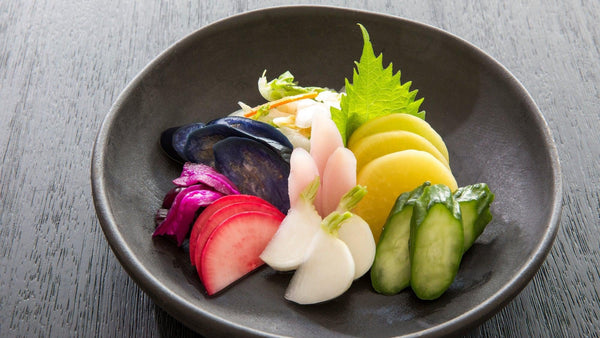
Jump to:
What is tsukemono?
Well, perhaps you’ve noticed a small dish of colorful, tangy vegetables alongside your main course in a Japanese restaurant?
Those aren't just garnishes – they're tsukemono, an integral part of Japanese cuisine.
Tsukemono runs the whole range of pickled goodness – from the bright yellow of takuan to the vibrant red of umeboshi. Tsukemono add both visual appeal and a punch of flavor (the old 1-2 combo of looks & taste in Japanese cuisine) to any Japanese meal.
But what exactly are these pickled delights, and why are they so beloved in Japan? In this edition of the Japanese Taste blog, we're getting pickled with Tsukemono, looking at how they're made as well as the many varieties you might encounter.
Japanese Pickles: Just What Exactly Is Tsukemono?

Tsukemono, which literally translates to "pickled things," is the Japanese term for pickles.
But these aren't your average dill pickles or sauerkraut!
Tsukemono encompasses a wide variety of vegetables and even some fruits, preserved through various pickling methods that have been refined over time in Japan.
These pickles play a crucial role in Japanese cuisine. Not just condiments or side dishes – tsukemono are considered an essential component of a traditional Japanese meal. In fact, the classic ichiju-sansai meal structure – one soup, three sides – typically includes tsukemono as one of the sides (accompanying rice, miso soup and the main dish).
Tsukemono can be made from almost any vegetable you can think of. The most common raw ingredients for tsukemono are Japanese daikon radish, cucumbers, eggplant, carrots, cabbage. But there are practically an endless supply of pickling possibilities.
The pickling methods themselves can vary widely too, from a simple salt brine to more complex processes involving rice bran, sake lees or even beds of malted rice.
The result is a diverse array of pickles that range from crunchy to tender, salty to sweet, and mild to intensely flavored. Some, like gari (pickled ginger), are familiar to sushi lovers worldwide. Others, like nukazuke (vegetables fermented in rice bran), might be new territory for those outside Japan.
But no matter the variety, tsukemono serve several important functions in Japanese cuisine. They act as a palate cleanser, refreshing the mouth between bites of other dishes. They provide a contrast in flavor and texture to the main components of the meal. And perhaps most importantly, they add an extra dimension of umami – that savory, deeply satisfying taste that's so prized in Japanese cooking.
Plus, tsukemono are a part of Japanese cuisine known as hakko shokuhin – fermented foods. You can read all about the background and benefits in our article on hakko shokuhin.
In the following sections, we'll delve deeper into why tsukemono became such an important part of the Japanese diet, how they're made and the many varieties you might encounter.
Why Is Tsukemono Popular In The Japanese Diet?

Tsukemono's popularity in Japan is about more than flavor. It’s deeply rooted in Japan's history and culture.
Here's why these pickles have become such a staple:
- Preservation: Before refrigeration, pickling was a crucial method of preserving vegetables for the winter months. This practical necessity eventually evolved into a culinary art form.
- Digestive aid: Many Japanese believe that tsukemono aids digestion, making it a perfect accompaniment to rich or heavy meals.
- Palate cleanser: The sharp, tangy flavors of tsukemono help refresh the palate between different dishes, enhancing the overall dining experience.
- Nutritional boost: Pickling can increase the vitamin content of vegetables, particularly B vitamins. Some tsukemono are also good sources of probiotics.
- Waste reduction: Pickling was a way to use up vegetables that might otherwise go to waste, reflecting the Japanese principle of mottainai (avoiding waste).
- Cultural significance: Tsukemono making is often a family tradition, with recipes passed down through generations.
Like pretty much everything else in Japanese cuisine, tsukemono are packed with flavor AND purpose.
How Is Tsukemono Typically Made?

The basic principle of making tsukemono involves subjecting vegetables to an environment that discourages the growth of harmful bacteria while encouraging the growth of beneficial bacteria. This is typically achieved through one or more of the following methods:
- Salting: The simplest method, where vegetables are covered in salt to draw out moisture
- Brining: Vegetables are immersed in a salt water solution
- Fermenting: Vegetables are fermented in a medium like rice bran or sake lees
- Vinegaring: Vegetables are pickled in a vinegar solution
- Pickling in nuka: A traditional method using rice bran mixed with salt, kombu and sometimes other ingredients
The pickling time can range from a few hours for quick pickles to several months or even years for more complex varieties.
Want a recipe? Check out our article detailing a quick but effective tsukemono pickling method.
Common Vegetables Used For Tsukemono In Japan
While almost any vegetable can be turned into tsukemono, some are more common than others:
- Daikon radish: Used for takuan, a yellow pickle often served with sushi
- Cucumbers: The base for many quick pickles
- Eggplant: Often used in nukazuke pickles
- Napa cabbage: The main ingredient in kimchi-like pickles
- Ume (Japanese plum): Used to make umeboshi
- Ginger: Pickled to make gari and benishoga.
- Turnips: Often used for quick pickles or fermented pickles
- Shiso leaves: Used in shibazuke and other pickles for their distinct flavor
Got some other vegetables in mind for tsukemono pickling? You really can’t go wrong.
Essential Styles Of Tsukemono in Japanese Cuisine
Japanese cuisine offers a range of tsukemono, each with different flavors, uses and benefits.
Shiozuke (Salt Pickles)

The simplest form of tsukemono, shiozuke involves pickling vegetables in salt. This draws out water from the vegetables through osmosis, creating an environment inhospitable to harmful bacteria. Shiozuke can be quick pickles made in a matter of hours, or long-term pickles that develop more complex flavors over time.
Nukazuke (Rice Bran Pickles)

Nukazuke is made by fermenting vegetables in a bed of rice bran (nuka). The nuka bed is a living ecosystem of beneficial bacteria and yeast, which impart a distinctive flavor to the vegetables. Making nukazuke is often considered an art form, with the nuka bed requiring daily maintenance.
Shoyuzuke (Soy Sauce Pickles)

These pickles are made by marinating vegetables in soy sauce, often with added ingredients like mirin or sake for extra flavor. Shoyuzuke tends to have a strong, salty flavor and a dark color from the soy sauce.
Misozuke (Miso Pickles)

Misozuke involves pickling vegetables or fish in miso paste. The salt and fermented soybeans in miso create a flavorful pickle with a distinct umami taste. Misozuke can range from quick pickles to long-term fermented varieties.
Kasuzuke (Sake Lees Pickles)

These pickles are made using sake lees (kasu), the residual yeast left over from sake production. Kasuzuke has a subtle, alcoholic flavor and is often used for fish as well as vegetables.
Amazuzuke (Sweet Vinegar Pickles)

Amazuzuke is made by pickling vegetables in a mixture of sugar and vinegar. These pickles tend to be sweeter than other varieties and are often served as a refreshing side dish.
Karashizuke (Mustard Pickles)

These pickles are made with a mixture of salt, sugar and Japanese mustard (karashi). They have a spicy kick that sets them apart from other tsukemono.
Su-zuke (Vinegar Pickles)

Su-zuke pickles are made primarily with vinegar. They're often quick pickles and have a tart, refreshing flavor that pairs well with rich dishes.
Fun fact / quick language lesson time: Did you notice that each of the aforementioned tsukemono varieties ends in “zuke”? That’s because they each take on the suffix “zuke” which is actually the prefix “tsuke” in “tsukemono.” TIL!
Other Types Of Tsukemono
In addition to the heavy hitters listed above, there’s a full range of tsukemono to be found in Japanese cuisine.
Benishoga (Red Pickled Ginger)

This vibrant red pickle is made from young ginger pickled in umezu (plum vinegar). It's often served with yoshoku (Western-style Japanese dishes) like curry or tonkatsu.
Gari (Pickled Ginger)

Familiar to sushi lovers worldwide, gari is young ginger pickled in a sweet vinegar solution. It's used as a palate cleanser between different types of sushi.
Takuan (Pickled Daikon)

This bright yellow pickle is made from daikon radish fermented in rice bran, salt, and sometimes turmeric for color. It has a crunchy texture and slightly sweet flavor.
Umeboshi (Pickled Plum)

These intensely sour and salty pickles are made from ume, a fruit often translated as "plum" but more closely related to apricots. Umeboshi are believed to have health benefits and are a common addition to bento boxes.
Want to try some umeboshi? We’ve got them in store now, specifically the J Taste Umeboshi Natural Pickled Nanko Plums With Honey 500g.
Sunomono (Vinegar Pickles)

Sunomono refers to a variety of vinegar-based pickles, often made with cucumbers. These quick pickles are light and refreshing.
Eggplant Tsukemono

Eggplant pickles can be made in various styles, but are often prepared as nukazuke or misozuke. The soft texture of eggplant allows it to absorb flavors well.
Senmaizuke (Pickled Turnip)

A specialty of Kyoto, senmaizuke is made from thinly sliced turnip pickled with konbu (kelp) and flavored with red shiso leaves.
Napa Cabbage Tsukemono

Napa cabbage is often quick-pickled in salt or vinegar, creating a crunchy, refreshing side dish.
Shibazuke

A specialty of Kyoto, shibazuke is made from eggplant, cucumbers and myoga ginger pickled together with red shiso leaves, giving it a distinctive purple color and complex flavor.
Rakkyo (Pickled Scallion)

These small, white pickles are made from a type of scallion. They're often served as a condiment with curry.
Much More Than Garnish: The Essence Of Tsukemono
As you can see, tsukemono isn’t just some random pickle thrown on a plate for garnish/filler. Tsukemono plays a key role in Japanese cuisine, and its absence in an (otherwise) proper meal would quickly be noticed by any Japanese person.
From the quick and simple shiozuke to the complex, long-fermented nukazuke, there's a tsukemono for every palate.
The next time you encounter these colorful pickles, take a moment to appreciate the true meaning, function and flavor of tsukemono.
Better yet, try making your own! With just a few simple ingredients, you can bring a taste of Japan to your own kitchen.


0 comments